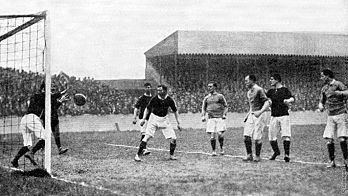Full name Manor Ground Opened 1888 Owner Arsenal F.C. | Closed 1913 Capacity 33,000 Demolished 1913 | |
 | ||
Similar | ||
The Manor Ground in Plumstead, south east London was a football stadium which, between 1888 and 1890, and 1893 and 1913, was the home of the football club formerly known as Royal Arsenal, renamed Woolwich Arsenal in 1893, and later simply Arsenal F.C. soon after they moved across London to Arsenal Stadium, Highbury.
History
Under their original name of Dial Square, the club's very first match in December 1886 was on a field in the Isle of Dogs, most likely by Glengall Road (now known as Tiller Road). After that, for the rest of the 1886-87 season, the newly renamed team Royal Arsenal played on Plumstead Common. They moved in September 1887 to a pig field on Plumstead Marshes, which was renamed the Sportsman Ground after the Sportsman pub nearby. They continued to play there for the next six months.
In 1888, after the Sportsman Ground had flooded, the club moved to the adjoining Manor Field (as it was originally known), which was soon renamed Manor Ground. The pitch was notoriously muddy and on its southern side ran the Southern Outfall Sewer. There were no stands as such; the club used wagons borrowed from nearby Army bases to house spectators. The club's first match there was against Millwall Rovers, on 30 March 1888; it finished 3-0 to Arsenal.
In 1890, Royal Arsenal decided to move to the much more suitable Invicta Ground (which possessed a stand, terracing and changing rooms), on the south side of Plumstead High Street. They stayed there for three years (in the meantime changing their name to Woolwich Arsenal, and turning professional), before leaving after the owner of the Invicta raised the rent on the ground. Arsenal bought the Manor Ground with money raised from a share issue, erected a single main stand and banks of terracing, and moved back there before the start of the 1893-94 season, in time for the club's Football League debut. The stadium averaged a gate of 6,000 that season.
Woolwich Arsenal continued to play their home matches at Manor Ground for the next twenty years, with two exceptions. They were forced to stage one league fixture against Burton Swifts at New Brompton's Priestfield Stadium and one against Leicester Fosse at Lyttelton cricket ground, Leyton in 1895; the Manor Ground had been closed by the Football League for a period of five weeks after crowd trouble at a match against Burton Wanderers in January of that year.
In 1904 a second stand was added (this is the earliest known terrace in the country to be nicknamed Spion Kop, although many other clubs, such as Liverpool, also built eponymous stands that were better known). With the club having achieved promotion to the First Division that year, with the additional capacity attendances reached over 20,000 for some matches. However, attendances soon dipped, thanks in no small part to the Manor Ground's relatively isolated location, in an industrial area with few local residents.
After years of financial precarity, in 1910 Woolwich Arsenal faced bankruptcy, with the club managing an average crowd of only 11,000, compared to Chelsea's average gate of 28,000. That year, London property magnate and Fulham chairman Sir Henry Norris bought Arsenal out, rescuing the club, and he proceeded to move them all the way across London to the new Arsenal Stadium in Highbury three years later, after an attempt to merge Fulham and Arsenal failed.
Woolwich Arsenal played their last match at the Manor Ground on 26 April 1913, a 1-1 draw against Middlesbrough watched by only 3,000 people. After they left, the ground soon fell derelict, and was eventually demolished and the land redeveloped. Today it is home to an industrial estate; the stadium's former site is roughly bound by Nathan Way, Griffin Manor Way and Hadden Road. Arsenal's departure was one reason for another local club, Charlton Athletic, to turn professional in 1920 and taking their place as the area's main club.
